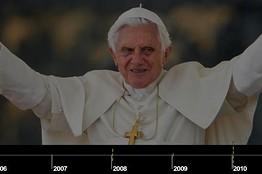By Stacy Meichtry
Wall Street Journal
July 15, 2010
http://online.wsj.com/article/SB10001424052748704682604575368612000147250.html?mod=googlenews_wsj
ATICAN CITY—The Vatican issued an account of its policies for handling sex-abuse cases over the past century in a bid to quell criticism that the Holy See fostered a culture of cover-ups within the Roman Catholic Church ranks.
The Vatican published the account on Thursday as a "historical introduction" to a set of revisions updating Vatican policy for disciplining sexually abusive priests.
The revisions toughen Vatican sex-abuse rules by doubling the statute of limitations for sex-abuse to 20 years and dropping requirements for clerics to act as judges in church trials.
Current rules were first laid out in a 2001 decree by late Pope John Paul II. The latest revisions were approved by Pope Benedict XVI on May 21, 2010, the Vatican said.
The Congregation for the Doctrine of the Faith, the office in charge of disciplining abusive priests, "held it necessary to proceed with a reform," Cardinal William Levada, the congregation's top official, said in a statement.
With the revisions, Cardinal Levada added that the rules would be "more useful."
The revised rules stop short of requiring bishops world-wide to report sex abuse to civil authorities. Victims of sex abuse say current Vatican laws, which call for church officials to comply with civil laws, aren't enough to protect children because many countries don't have laws that require the reporting of sex abuse.
In the document issued on Thursday, the Vatican makes a rare attempt to clarify how one of the world's most opaque institutions changed its laws over the decades—policy shifts that sewed confusion throughout the church hierarchy and ultimately allowed widespread abuse to go unreported over several papacies.
Although the account provides a broad policy overview, it doesn't shed light on how the Vatican handled specific cases or how many. Thousands of priests have been disciplined under Pope John Paul II's 2001 decree, or motu proprio. Little is known about cases were handled before then.
In the document, the Vatican traces its sex-abuse policies back to 1917, when the Congregation for the Doctrine of the Faith, then known as the Holy Office, was first assigned responsibility for disciplining priests who committed "a certain number of crimes." A 1922 "instruction" to bishops from the Holy Office defined those crimes as the use of confession to solicit sex, including homosexual acts, sex with children and bestiality, according to the Vatican account.
The 1922 instruction, titled Crimen Sollicitationis, Latin for "the crime of solicitation," has been a lightning rod for debate ever since the Vatican disclosed its existence in the wake of the 2002 sex scandal in Boston. Victims of sexual abuse cited Crimen as evidence that the Congregation for the Doctrine of the Faith, the office that Pope Benedict headed for two decades before becoming pope, failed to exercise its authority to stop pedophile priests.
Crimen, which was reissued in 1962, also stipulated that sex-abuse cases are covered by the "secret of the Holy Office," a level of secrecy under church law that calls for excommunication for anyone who violates it.
Canon lawyers say Crimen's secrecy requirement aimed to protect the confidentiality of the people involved in the cases and wasn't intended to stop church officials from report sex abuse to civil authorities. Lawyers for sex-abuse victims who have brought lawsuits against the Vatican, however, have cited Crimen as evidence in civil trials that the Holy See aimed to obstruct justice.
On Thursday, the Vatican's overview played down Crimen's significance. The document "should have been distributed to bishops attending the Second Vatican Council … but most of the copies were never distributed," the Vatican said, referring to the world-wide meeting of bishops in the 1960s that paved the way for the modernization of the Catholic Church.
"Crimen Sollicitationis was, therefore, never intended to represent the entirety of the policy of the Catholic Church regarding sexual improprieties on the part of the clergy," the Vatican said on Thursday. "Rather, its sole purpose was to establish a procedure that responded to the singularly delicate situation that is a sacramental confession, in which the duty of complete confidentiality on the part of the priest corresponds, according to divine law, to the complete openness of the intimate life of the soul on the part of the penitent," the Vatican said.
Judging Crimen according to the current "perspective" on sex abuse is "gravely anachronistic," the Vatican added.
 |
| A Cloud at the Vatican |
The Vatican also sought to distance the Congregation for the Faith from criticisms of the Vatican's handling of sex-abuse cases before 2001. In the decades that followed Second Vatican Council of the 1960s, "a small number of cases concerning sexual misconduct of clergy with minors" were reported to the Congregation for the Doctrine of the Faith, the Vatican said. During that period, bishops began to assert more independence from the Vatican, leading to a "de-centralized approach," the Vatican said.
Bishops relied on a "therapeutic model" that favored psychiatric treatment instead of punishing abusive priests. A 1983 code of canon law called for bishops to set up church trials in their dioceses to prosecute priests accused of abuse, further limiting the Congregation for the Doctrine of the Faith's reach, the Vatican said.
Appeals in these cases, under the 1983 law, were heard by the Rota Romana, a Vatican court, the Vatican said, adding that accused priests could also file complaints over the handling of their cases to the Congregation for the Clergy.
It wasn't until 2001, with John Paul II's decree, that the Congregation for the Doctrine of the Faith was given clear jurisdiction over sex-abuse cases, the Vatican said.
Contact: stacy.meichtry@wsj.com
Any original material on these pages is copyright © BishopAccountability.org 2004. Reproduce freely with attribution.